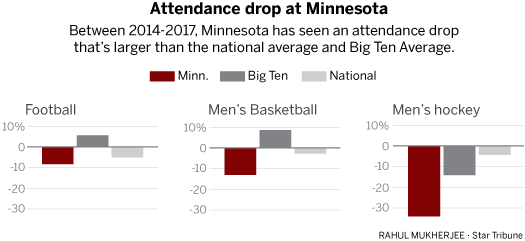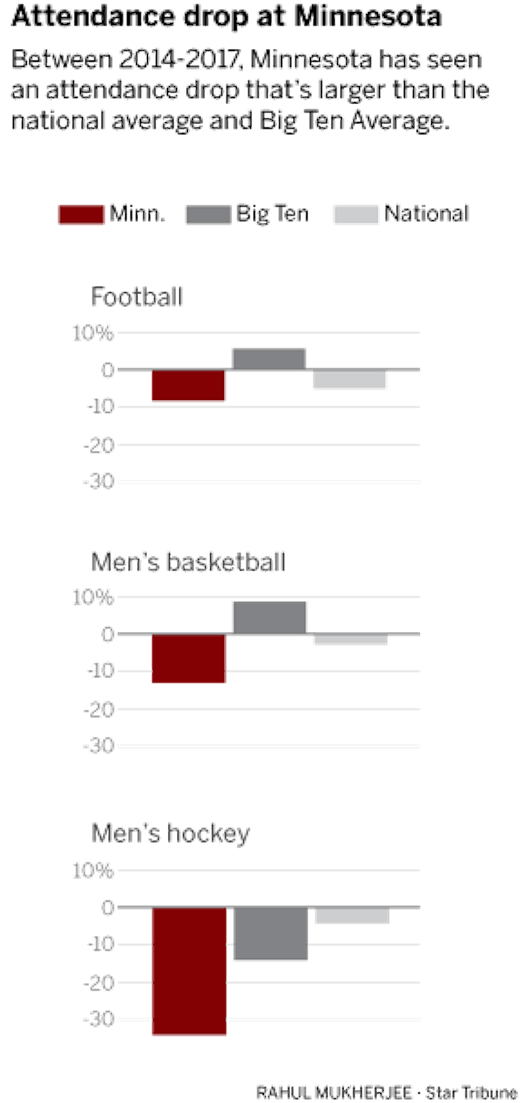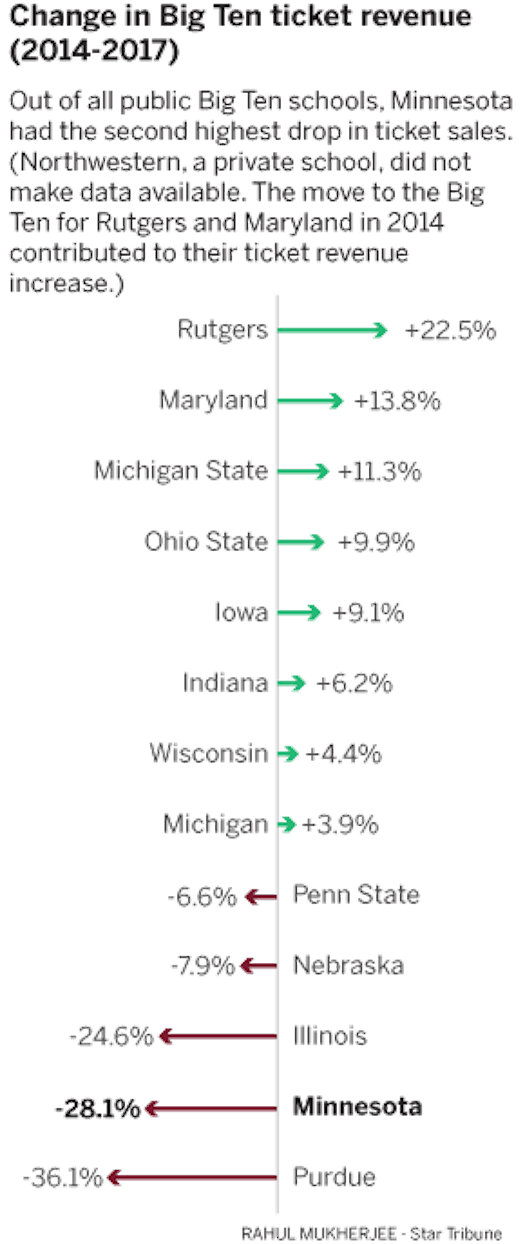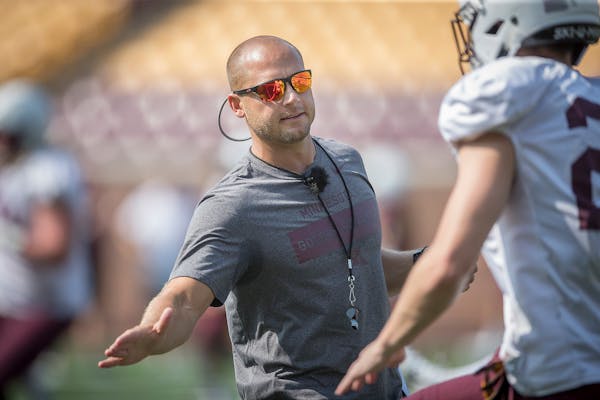Long before he came to Minnesota, Mark Coyle heard a proverb that stuck with him. Money isn't the most important thing in college athletics, the saying goes, but it's right up there with oxygen.
Though the Gophers athletic director grinned when he recalled those words, the message is serious — particularly when plunging ticket sales mean the Gophers are not breathing as easily as Coyle would like.
In three years, ticket revenue from Gophers sports fell by $8 million — a 28 percent drop — to $20.5 million in 2017, according to the most recent accounting. Most of the decline occurred in football, men's basketball and men's hockey, the three sports the U counts on to help fund the entire athletic department.
Ticket sales have long been a top revenue stream for Gophers sports, and the escalating costs of running an athletic department make it more essential than ever to fill those seats. "We need ticket sales to pick up for us," Coyle said. "Ticket sales is the lifeline of your program, and we need to pay attention."
Empty seats this school year will come in more colors than just maroon and gold. College football's average attendance fell 3.2 percent last season, the second-largest drop since the NCAA began keeping records in 1948. The numbers for Division I men's basketball are sagging, too; the national average attendance rose slightly last year to 4,807, ending a 10-year decline, but that is well below the 2007 average of 5,548.
"Every university, every athletic department, every conference is talking about this at the highest levels," said Mike Wierzbicki, the Gophers' assistant athletic director for fan development. "People see a marquee game in prime time on TV and think everything's perfect. But there's a lot more to it."
With his department's budget set at $121 million for the coming year, Coyle is overseeing changes designed to get more paying customers through the doors. Last year, the U began placing greater emphasis on courting groups and businesses, and it has cut prices for some football and men's hockey tickets. Ryan Dillon, assistant athletic director for ticket sales and service, said the new approach has boosted ticket revenue by 1 percent in 2018.
Fans will continue to see swaths of empty seats at football games, however. The Gophers sold 27,885 non-student season tickets three years ago, but that number sat at 21,522 as of last week. Football attendance did increase slightly per game last season, but there's work to be done to fill TCF Bank Stadium this fall. Just over 37,000 tickets have been distributed for Thursday's opening game — 6,000 short of last August's opener.
Coyle worked in Gophers marketing earlier in his career and noted the landscape has changed markedly since those days. Now, as the department head, he's building a team to seek solutions.
"Our revenue from [football, men's basketball and men's hockey] is about $56 million, and ticket sales is a big part of that," Coyle said. "Despite the trends that are happening nationally, we need to do everything we can to make sure people want to purchase tickets and be part of our program. It's critical."
In 2014, the U's three most lucrative sports raked in a combined $26.7 million in ticket revenue. That dropped to $19.1 million in 2017. The biggest declines came from men's hockey, down 33.5 percent, and football, down 28.8 percent.
Coyle said the department's fundraising has reached record levels, so the slump in ticket revenue has not caused immediate financial harm. But a continued decline could hurt future budgets, and dwindling attendance will dampen the atmosphere at games. Though Coyle acknowledged that "we need to win in those revenue sports" to stimulate demand, the problem is more complicated than that.
With nearly every game on TV, it's far easier and cheaper to watch from the couch. Big screens have enhanced the home viewing experience, and cellphones and other portable devices allow viewing on the go. Game times that are inconvenient or announced only a few days in advance add to the hassle factor, as do family schedules crammed with youth sports and activities.
"The everyday life of a consumer is far different than it was 15 or 20 years ago," Wierzbicki said. "We have to provide them something that's different. We have to wow them to the extent they're willing to put on a coat, get in the car and do things that aren't as easy as sitting on the couch. That's the challenge."
Even prestige programs are finding it daunting. Wisconsin went 13-1 last season but had its lowest homecoming game attendance in 22 years. Clemson won the 2016 national championship but couldn't sell out the student section last fall — even though tickets were free.
The Gophers were an anomaly in college football last season; while their attendance crept up by 544 fans per game, the national average at top-division programs dropped by 1,409. The downturn in men's basketball extends all the way to March Madness, with average attendance for last year's NCAA tournament games down nearly 2,600 compared to 2008.
To combat declines, Coyle changed the way the U sells tickets. He brought in Dillon, whose career had been spent in Major League Baseball, and refashioned the department on a pro-sports model. "Outbound sales" — proactively seeking new customers — used to be outsourced but is now handled by a five-person in-house team. They target corporations and groups, strong avenues for growth, and now play host to bachelor and birthday parties, high school bands, first responders and health care workers.
The U also is offering more "mini-plan" packages, to appeal to fans pressed for time or money, and new entertainment on gamedays, such as street festivals, food trucks and beer gardens.
"You need to control the things you can," Dillon said. "You can't just open the doors and expect people to show up."
Cheaper tickets are also part of the U's plan to stimulate sales. Football season tickets now start at $249, and the cost of men's hockey season tickets has been reduced in the area opposite the student section — marking only the second time the U has dropped the price of a season ticket in that sport.
But Dillon and Wierzbicki said their priority is to push ticket revenue higher, which requires other tactics. To entice fans to spend more, the U has introduced the Gopher Loyalty Program, giving ticket buyers exclusive activities such as attending band practice, meeting with Coyle over coffee or watching a movie on the big screen at TCF Bank Stadium. Those who spend more get to choose more activities from a list that now exceeds 170 experiences.
"To drive revenue, we need to ask, 'What is the value of being a season-ticket holder?' It needs to be more than just a ticket," Wierzbicki said.
Officials hope these up-close experiences can build more of the relationships between teams and fans that have helped drive interest in the Gophers' Olympic sports. All U sports that sell tickets but are not considered revenue producers, such as volleyball, softball and wrestling, generated more ticket revenue in 2017 than they did in 2014. Winning accounts for some of that. But many fans feel deep connections to those sports and their stars, such as former Gophers great Lindsay Whalen. Since she was hired as women's basketball coach in April, season ticket revenue has increased 92 percent over last year, and new season-ticket sales are up 1,200 percent.
"When you have a team that does things the right way, people want to be part of that," Coyle said.
The U knows more than ever about what customers want. It has created a fan advisory board, and it frequently seeks feedback via surveys and data mining. The ultimate aim, Wierzbicki said, is to retain season-ticket holders while bringing in new fans, particularly families and young people.
"We have ambitious goals of filling up our stadiums and arenas," Dillon said. "We need to wake the sleeping giant that is the University of Minnesota.''

Five extra points: 'Bad Sam' Darnold, Titans run game kept in check while officials keep busy

Josh Allen seals Bills' 30-21 win over Chiefs with TD run, ending bid for perfect season

Backup QB Arbuckle leads Toronto past Winnipeg 41-24 for the Argonauts' 19th Grey Cup title

Scoggins: What does Vikings' 8-2 record say about them?








